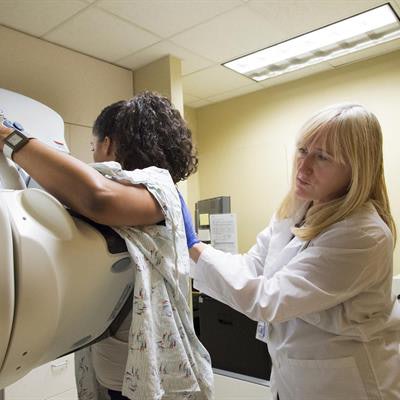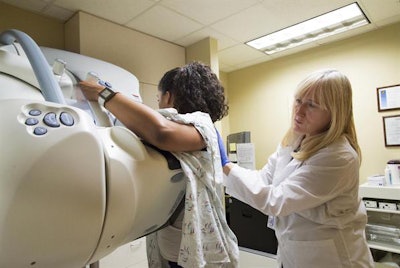
The benefits of digital breast tomosynthesis (DBT) are strongest for women undergoing their first breast screening. DBT had better initial cancer detection and recall rates than digital mammography in a large, long-term study published on July 28 in JAMA Network Open.
The study included a diverse group of women who underwent more than 1.5 million DBT and digital mammography examinations at dozens of imaging facilities across the U.S. All types of women saw improved outcomes on their first DBT scan, but for subsequent exams, the benefits of DBT varied by age -- and were nonexistent for women with extremely dense breasts.
"DBT is improving screening outcomes for the vast majority of women getting screening mammography," stated co-lead study author Dr. Kathryn Lowry, an assistant professor of breast imaging at the University of Washington School of Medicine, in a press release. "Unfortunately, it does not seem to benefit the 10% of women who have extremely dense breasts and who already experience the poorest of mammography outcomes today."
 A radiology technician helps prepare a patient for screening mammography at the University of Washington Medical Center - Roosevelt in Seattle. Image courtesy of UW Medicine.
A radiology technician helps prepare a patient for screening mammography at the University of Washington Medical Center - Roosevelt in Seattle. Image courtesy of UW Medicine.In the study, co-lead authors Lowry and Kaiser Permanente biostatistician Yates Coley, PhD, parsed data from nearly 1.6 million breast screening exams to identify which types of women DBT works best for. The study focused on women between the ages of 40 and 79 without a personal history of breast cancer, breast augmentation, or mastectomy.
| Digital mammography vs. DBT, initial breast screening | ||||
| Recall rate | Cancer detection rate* | |||
| Mammo | DBT | Mammo | DBT | |
| Ages 40-49 | 24% | 21.5% | 3.2 | 4.4 |
| Ages 50-59 | 24.1% | 20.4% | 5.9 | 8.8 |
| Ages 60-79 | 21.9% | 17.8% | 10.8 | 15.1 |
On initial screening, women of all ages and breast densities had significantly fewer recalls and higher cancer detection rates with DBT than digital mammography. DBT was also better at baseline for detecting invasive cancers.
On subsequent screenings, though, the findings were more varied. Cancer detection and recall rates were still significantly better on DBT for women of all ages with heterogeneously dense breasts and for women between the ages of 50 and 79 with scattered fibroglandular density.
| Digital mammography vs. DBT, subsequent breast screenings | |||||
| Breast density | Age | Recall rate | Cancer detection rate* | ||
| Mammo | DBT | Mammo | DBT | ||
| Almost entirely fat | Ages 40‑49 | 5.8% | 4.9% | 1.6 | 1.6 |
| Ages 50‑59 | 4.6% | 3.9% | 2.1 | 2.3 | |
| Ages 60‑79 | 5.1% | 3.9% | 3.8 | 3.9 | |
| Scattered fibroglandular density | Ages 40‑49 | 10.3% | 8% | 2.2 | 2.4 |
| Ages 50‑59 | 8.2% | 6.9% | 3.3 | 4 | |
| Ages 60‑79 | 7.4% | 6.1% | 5.5 | 6.5 | |
| Heterogeneously dense | Ages 40‑49 | 13.2% | 11.9% | 2.5 | 3.1 |
| Ages 50‑59 | 10.2% | 9.3% | 3.7 | 5.3 | |
| Ages 60‑79 | 8.7% | 7.7% | 6.1 | 8.5 | |
| Extremely dense | Ages 40‑49 | 11.2% | 12.2% | 2.5 | 2.7 |
| Ages 50‑59 | 9.1% | 9.3% | 3.7 | 4.4 | |
| Ages 60‑79 | 6.4% | 6.2% | 5.9 | 6.9 | |
Recall rates on subsequent exams were also significantly lower on DBT for women aged 50 or older with fatty breast tissue, as well as for those between the ages of 40-49 with scattered fibroglandular density. However, these groups did not also benefit from a higher cancer detection rate on DBT.
Notably, there was no significant improvement in either cancer detection rates or recall rates for women with extremely breast dense tissue after their first DBT examination. This finding disappointed the authors, as women with extremely dense breasts are already at a higher risk for developing cancer and having cancers missed on mammography.
"We hoped that it would benefit these women, but unfortunately, this adds to the evidence that we still need to think about how to improve screening for this group," Lowry stated.
The authors noted alternative screening methods, such as MRI or ultrasound, may need to be considered for women with extremely dense breast tissue. Nevertheless, the findings may still help providers determine which patients should get priority to DBT in settings with limited resources.
"If a patient has to pay out of pocket or drive several hours to reach a provider who offers DBT, this can help them know whether they're likely to experience a benefit," stated Coley.



















